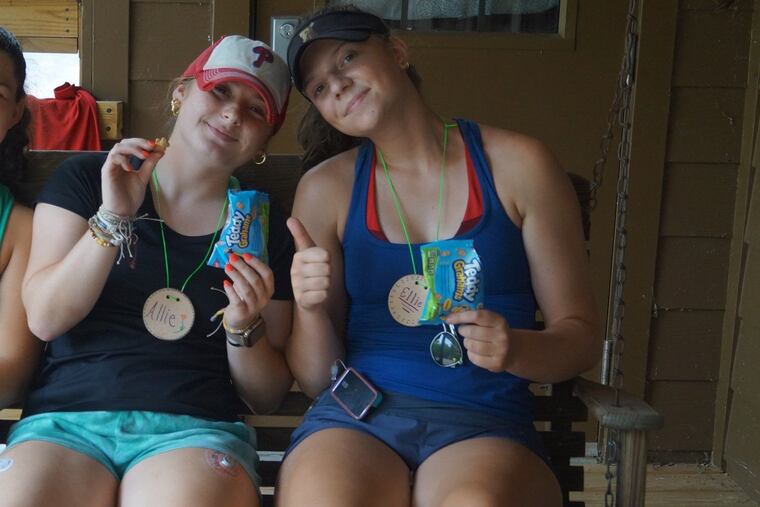Diabetes camp should be fun. Instead, we worry about the cost of insulin.
The high cost of insulin in the U.S. is a dark cloud looming over what should be a fun, relaxing week at diabetes camp.

As a 17-year-old Type 1 diabetic, I’ve attended a camp for diabetics in Pennsylvania for the last few summers -- first as a camper, and as of last year, a counselor-in-training. At the end of the session this past summer, I remember sitting on a rock at the edge of the dusty road that leads from our little oasis to the outside world. Most campers had left, and I was enjoying the smooth summer breeze and a moment of calm after a chaotic week of managing dozens of tweenager kids.
My friend and fellow counselor Allie joined me on the rock. I felt as if I had to bring up something that had loomed like a dark cloud over an otherwise very pleasant and joyful week at camp: insulin. It’s the thing that keeps us all alive, but it and the other medical supplies that diabetics need have become more and more unaffordable.
Allie, of course, knew what I was talking about. We reflected on the statistic that one in four diabetics in the United States says they cut back on insulin due to cost. “Let’s say there are 16 kids in our cabin,” said Allie. “That means four of them are rationing their insulin.”
I sat there, thinking. Many of the campers who had just driven down the dusty road away from camp had paid a hefty enrollment fee to attend, but some had received subsidies or financial assistance; all got free insulin while they were here. How many were going to homes where they couldn’t be sure they’d have the medical supplies they need to stay alive?
This isn’t just a problem for the campers. The counselors aren’t paid to attend the camp, but many are motivated to keep coming because they receive a portion of the leftover insulin and medical supplies at the end of camp — their only form of payment. And whenever counselors got together away from campers, insulin was never far from our minds. Those who were in their 20s discussed how they weren’t enjoying their jobs but were afraid to switch career paths because they’d temporarily lose their health insurance. One older counselor told a group of us still in high school to “find a job working for the government,” because they provide the best health insurance. Another counselor my age said she had given her hairdresser, who is also a Type 1 diabetic, vials of insulin because he can’t afford it.
This collective anxiety about medical expenses is probably unique to diabetic camps in the United States, where insulin costs 10 times as much as it does in other developed countries.
“In the U.S., insulin costs ten times as much as it does in other developed countries.”
That statistic tells me insulin doesn’t have to be as expensive as it is here. Which makes it a political problem.
But for the 7.4 million Americans who depend on insulin, this issue isn’t political. It’s one of life and death.
Allie and I come from families who are on opposite ends of the political spectrum — mine, more liberal, and hers, more conservative. But on this issue, we want the same thing for ourselves and our campers: easy and anxiety-free access to the medical supplies we need to live.
» READ MORE: A nonprofit drugmaker may offer people with diabetes insulin price relief l Expert Opinion
Allie is only a junior in high school, but she is already worried about her future. “The fact that I’m going to have to pay for my own insulin when I’m out of college is terrifying,” she told me. Her mother has said she would live on cereal and milk if that’s what it took to afford Allie’s insulin; it’s not very reassuring.
For the people most affected by the insulin affordability crisis, it’s hard to watch the bipartisan bickering over the issue. House Democrats are jumping at the opportunity to ensure insulin affordability “for all” (as they advertise), and recently passed a bill that caps costs at $35 per month. But Republicans are quick to criticize their efforts, and the bill may be doomed in the Senate.
There is no easy fix to this problem. Capping co-pays may seem like one, but the current House bill will do nothing for uninsured diabetics who carry the worst burden of medical costs. Those who are insured will end up paying less in co-pays while insurance companies could simply pass their increased costs to all customers in the form of higher premiums.
The problem of high health-care prices in America is vast and difficult to boil down, no matter how desperately a political party wants good press.
As for me, I’m getting ready to work at diabetes camp again this summer. I hope it gives campers and us counselors a break from our never-ending stress about insulin. I look forward to the time when I can wave everyone off at the end of the week as they drive down the dusty road leading from camp, and not worry about how they will be able to afford to stay alive.
Ellie Davis recently graduated from Radnor High School.